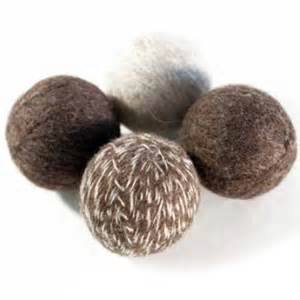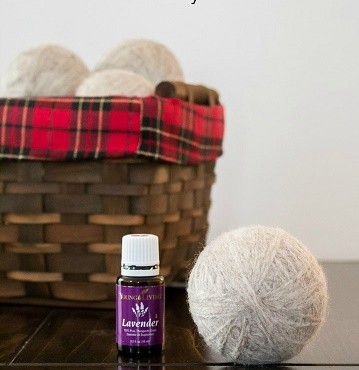Have you tried felted wool dryer balls?
 Many options exist to help dry your laundry faster and keep it free from static. But have you looked at the list of ingredients on those scented dryer sheets? Even the unscented ones are full of chemicals.
Many options exist to help dry your laundry faster and keep it free from static. But have you looked at the list of ingredients on those scented dryer sheets? Even the unscented ones are full of chemicals.
Instead of loading your laundry – that soft, precious fabric that touches your skin every day – with stinky chemicals that are in dryer sheets, these felted wool dryer balls will do the same job in less time. In a nutshell: The wool soaks up some of the moisture in your laundry as it dries, but then evenly distributes it into the air – helping your dryer stay humid longer, which greatly reduces static cling. In addition, this “soaking and releasing” action makes your clothes dry faster. And all of these things together mean fewer wrinkles. Best of all, they’ll last up to 1000 uses or more! That’s years without having to worry a single bit about static, dryer sheets, wrinkles and, buying supplies. This is the best part of felted dryer balls.
Subscribe to our FREE email list and receive directions on how to easily make your own wool dryer balls! (directions sent by email)
What are the benefits of using wool balls in your dryer?
- They decrease drying time, saving you money on utility bills.
- Commercial fabric softeners and dryer sheets are filled with harmful chemicals and perfumes that coat your clothing, eventually ending up on your skin. There are no chemicals in wool dryer balls!
- Commercial dryer sheets can be costly, and are thrown away after use. Wool dryer balls can be re-used for years, saving you hundreds of dollars.
- Commercial fabric softeners shouldn’t be used on cloth diapers. Wool dryer balls are perfect for keeping your cloth diapers soft and chemical-free.
- Wool dryer balls won’t affect the absorbency of your towels, kitchen cloths, or cloth diapers – commercial softeners will.
- 100% wool balls increase fluffiness & reduce static as dryer loads tumble.
- Dryer balls help to soften clothes naturally.
- Dryer balls are made from a renewable resource.
How do they work?
 It’s simple. They bounce around in the dryer separating clothes, allowing more hot air to circulate through all the garments. As they tumble, the wool balls fluff your laundry, reduce wrinkles, and basically pummel the laundry to make it softer. They do so much more than a dryer sheet by pulling moisture out of your clothes so you don’t have to run the dryer as long. The more dryer balls you have in a load, the shorter the drying time will be.
It’s simple. They bounce around in the dryer separating clothes, allowing more hot air to circulate through all the garments. As they tumble, the wool balls fluff your laundry, reduce wrinkles, and basically pummel the laundry to make it softer. They do so much more than a dryer sheet by pulling moisture out of your clothes so you don’t have to run the dryer as long. The more dryer balls you have in a load, the shorter the drying time will be.
Maybe you’re using those plastic PVC dryer balls because you don’t want the chemical scents from commercial products coating your laundry. The problem is, plastic releases all kinds of nasty chemicals when it’s heated. Ditto for tennis balls. Wool dryer balls are a much more natural, chemical-free alternative to all the other options out there.
Using your wool dryer balls
Just throw these babies in the dryer with your freshly washed clothes, and let them do their work! For regular loads, use at least 4-6 balls to notice a decrease in drying time. For large loads, use 6 or more wool balls. The more you use, the more quickly your clothes will dry.
Store your dryer balls in the dryer between uses or display them in a basket in your laundry room. (They’re pretty!) If you want to lightly scent your laundry you can add 1-2 drops of your favorite essential oil to each ball before throwing in the dryer. If you’re using a good quality, pure essential oil, you will not have trouble with the oils spotting your clothes.
Interested in high quality essential oils?
IMPORTANT INFORMATION ON DRYER SHEETS:
According to the author of The Brain Wash, there are the seven most common chemicals found in dryer sheets and their effect on the central nervous system: (see article)
- Alpha-Terpineol causes central nervous system disorders. Can also cause loss of muscular coordination, central nervous system depression, and headache.
- Benzyl Alcohol causes central nervous system disorders, headaches, nausea, vomiting, dizziness, central nervous system depression, and, in severe cases, death.
- Camphor on the US EPA’s Hazardous Waste list. Central nervous system stimulant, causes dizziness, confusion, nausea, twitching muscles, and convulsions.
- Chloroform on the EPA’s Hazardous Waste list. Neurotoxic and carcinogenic.
- Ethyl Acetate on the EPA’s Hazardous Waste list. Narcotic. May cause headaches and narcosis (stupor).
- Linalool causes central nervous system disorders. Narcotic. In studies of animals, it caused ataxic gait (loss of muscular coordination), reduced spontaneous motor activity, and depression.
- Pentane causes headaches, nausea, vomiting, dizziness, drowsiness, and loss of consciousness. Repeated inhalation of vapors causes central nervous system depression.`


